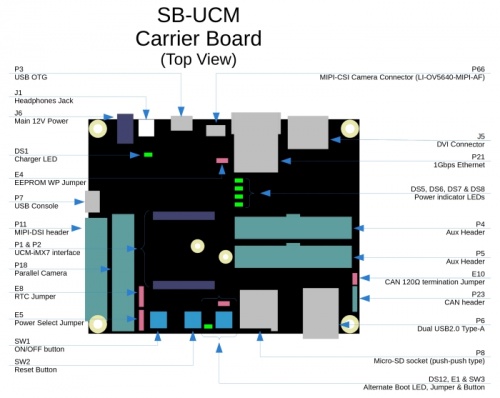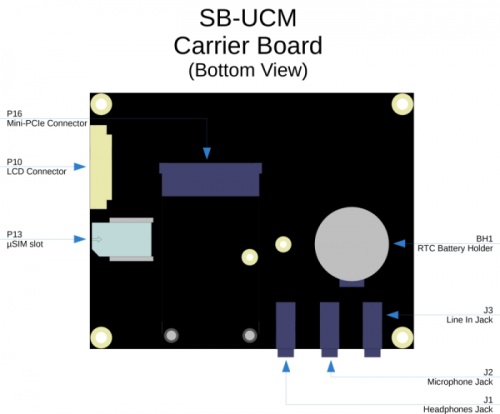UCM-iMX7: Evaluation Kit: Hardware Guide
Contents
Overview
Terms and Definitions
Term Definition Evaluation kit A combination of UCM-iMX7 & SB-UCM boards accompanied by a set of accessories detailed here UCM-iMX7 A system-on-module product described here SB-UCM A carrier board for UCM-iMX7, designed for reference, evaluation and development purposes SoM system-on-module Reference Carrier Board
The evaluation kit is shipped with SB-UCM, a UCM-iMX7 carrier board, designed for reference, evaluation and development purposes
The design materials for SB-UCM (including schematics, PCB layout and Bill of Materials) are available for download from here
Additional resources
Carrier Board
Interfaces and Functions
Main Power
Evaluation kit main power can be provided from either a Li-Poly battery, or a DC power source.
Option 1 - DC only
Connector J6 is the main DC power source of thе evaluation kit. The DC power supply unit included with the evaluation kit provides 12V DC power to the system through J6.
Option 2 - Li-Poly Battery
Battery powered operation of the evaluation kit is supported through the main battery connector P19. The evaluation kit is shipped with an accessory battery adapter allowing P19 connection to custom batteries. Please refer to battery specification for details on supported batteries.
Main Battery Charging
This evaluation kit supports main battery charging when both power sources (Battery + DC) are available. The DS1 LED indicates battery charging is in progress. Detailed status of the battery and charging process is available to software through I2C access to the SB-UCM on-board battery charger (U25 in SB-UCM schematics) and charging supervisor (U24 in SB-UCM schematics).
Serial Console
Serial console is available through USB interface, using micro-USB2.0 Type-B connector P7. Continue to USB console guide for USB interface setup instructions.
USB
All UCM-iMX7 USB ports are accessible with this evaluation kit:
- UCM-iMX7 Native USB Port 1 is available through the OTG connector P3.
- USB Host connection: The micro-USB to USB type-A adapter included with evaluation kit (available for purchase here) allows usage of connector P3 as a standard USB2.0 host port.
- USB Gadget connection: A standard micro-USB cable (included with evaluation kit) enables connection of the evaluation kit as a USB gadget to the USB port of your host computer.
- UCM-iMX7 Hub USB Port 1 is available through the bottom port of the dual stacked USB2.0 connector P6.
- UCM-iMX7 Hub USB Port 2 is available through the mini-PCI-express connector P16, enqabling connection of mini-PCIe form-factor USB devices such as 3G modems etc.
- UCM-iMX7 Hub USB Port 3 is available through the top port of the dual stacked USB2.0 connector P6.
- UCM-iMX7 Native USB Port 2 is accessible through the general purpose 100mil header P5 . Using the CONUSB adapter included with the evaluation kit (available for purchase here), allows connection of standard USB2.0 devices to these ports. P5 pins used the port are shown in table below
Pin Name UCM-iMX7 Native USB Port 2 Power 5V P5-27 Negative Data P5-29 Positive Data P5-31 GND P5-33
.
CAN
By default, only CAN1 interface is connected to the SB-UCM onboard CAN PHY and Isolator components with this evaluation kit.
- CAN bus nodes can be connected to evaluation kit header P5 as described in CAN node connection guide.
| Removing R143 + R145, then populating 0Ω resistors in R144 and R142 placeholders, enables connection of the CAN2 interface to SB-UCM onboard CAN PHY and Isolator components instead of CAN1 |
Ethernet
The kit features a single 1Gbps copper Ethernet port. The ethernet port is available through RJ45 connector P21.
PCI-Express
Plug your mini-PCIe device into the evaluation kit mini-PCIe connector P16. Full/Half size mini-PCIe boards are supported.
Wireless
WiFi/Bluetooth
Connect the antenna (included with evaluation kit) to UCM-iMX7 connector J1 for WiFi and/or Bluetooth operation.
Cellular
USB and/or PCI-express interfaced cellular modems (2G/3G/4G etc.) can be plugged into connector P16 (mini-PCI-Express) as explained below:
- Plug your modem into P16 mini PCI-Express connector.
- Insert your micro-SIM card into the P13 micro-SIM slot (only relevant if your cellular modem requires a sim card access while not featuring an onboard SIM slot).
Display
Evaluation kit supports display interfaces listed below (not simultaneously). Selection of active display interface is set by software.
LCD
Connect the LCD panel included with the evaluation kit the the system through the FPC connector P10. Consult the software documentation in order to make sure system is configured utilize LCD display on P10.
DVI
The DVI display interface is accessible through the HDMI connector J5.
MIPI-DSI
The UCM-iMX7 MIPI-DSI two lane display interface is accessible through evaluation kit header P11. This header enables simple connection (with jumper wires) to any MIPI-DSI enabled panel. Please refer to SB-UCM schematics for detailed information on P11.
System
Reset
Pressing the reset button (SW2) triggers evaluation kit cold reset.
Boot Sequence Selection
Evaluation kit supports normal and alternate boot sequences. Detailed description of the sequences is available in the UCM-iMX7 reference guide.
- Normal Boot Sequence: During early boot stages, UCM-iMX7 executes the U-Boot firmware flashed into the onboard SPI Flash.
- Alternate Boot Sequence: During early boot stages, UCM-iMX7 attempts to execute U-Boot firmware (if available) flashed into an SD card (at micro-SD slot P8) before falling back to U-Boot firmware pre-flashed onto the onboard SPI Flash.
- Pressing and holding the "Alternate boot select" button (SW3) during power-up or cold reset forces execution if the "Alternative Boot Sequence".
- Populating the E1 jumper, forces the "Alternate Boot Sequence" for every boot attempt.
- Indication of selected boot sequence is shown with the DS12 LED. (ON = "Alternate Boot Sequence" enabled).
Power ON / Cycle
- A short press of the ON/OFF button (SW1) while system is operational, generates an OFF request to be serviced by software.
- A long (>5Sec) press of the ON/OFF button (SW1) while system is operational, unconditionally shuts down the system (same as simply removing power source).
- A short press of the ON/OFF button (SW1) while system is off, triggers the system start-up sequence.
RTC
The evaluation kit RTC (implemented onboard UCM-iMX7) is powered by a coin cell battery. RTC power can be disconnected by:
- Removing the coin cell battery.
- Removing jumper E8.
To quickly discharge the RTC power, momentarily short pins 1 and 2 of jumper E8.

Never short pins 1 & 2 of jumper E8 while system power is available Multi functional signals access
Camera
Part of the UCM-iMX7 camera interface signals are accessible through the evaluation kit P18 header.
Please refer to UCM-iMX7 reference guide and SB-UCM schematics for details.
UART
UCM-iMX7 UART interfaces are partially accessible through headers P4, P5 and P18.
Please refer to UCM-iMX7 reference guide and SB-UCM schematics for details.
SPI
UCM-iMX7 SPI interface signals are partially accessible through headers P4, P5 and P18.
Please refer to UCM-iMX7 reference guide and SB-UCM schematics for details.
I2C
UCM-iMX7 I2C interface signals are partially accessible through headers P4, P5 and P18.
Please refer to UCM-iMX7 reference guide and SB-UCM schematics for details.
GPIO
Some of the UCM-iMX7 GPIO signals are accessible through headers P4, P5 and P18.
Please refer to UCM-iMX7 reference guide and SB-UCM schematics for details.
Jumpers Summary
- E1 - Boot Sequence/Production.
- E4 - SB-UCM board specific data EEPROM write-protection.
- E5 - MIPI-DSI display connector P11 power source selection.
- E8 - RTC coin cell connection
- E10 - 120Ω CAN termination enable/disable (populated = 120Ω CAN termination enabled, otherwise disabled)

